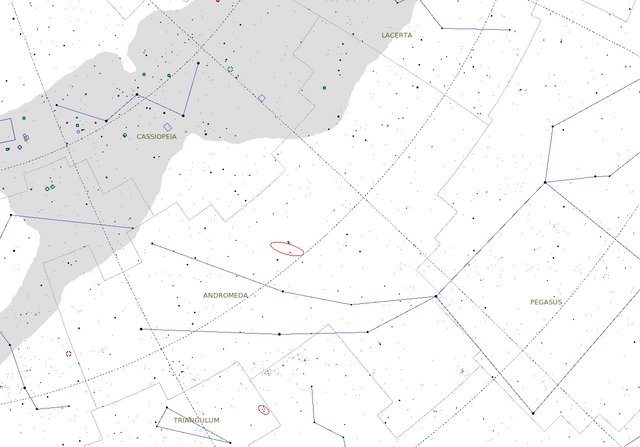Andromeda
| Andromeda |
| English Name:The Chained Maiden
Abbreviation:And Genitive:Andromedae Hemisphere:Northern Season:autumn |
The constellation of Andromeda lies in the northern half of the celestial sphere. It is bounded to the north by Cassiopeia and part of Perseus. To the east is Perseus. South of the constellation is Triangulum, Pisces, and Pegasus. Andromeda's western border is with the constellation Lacerta. The primary asterism that makes up the constellation looks like a bent "V" with the brightest star in the constellation, Alpheratz, at its vertex and the arms of the V moving to the east and north. Andromeda is high in the sky in the autumn.
Andromeda lends Alpheratz to the asterism of the Great Square of Pegasus. The constellation is also home to the galaxy M31 to which the constellation often gives it's name.
Contents |
History
According to Greek mythology, Andromeda was the daughter of King Cepheus and Queen Cassiopeia. Queen Cassiopeia was a vain and boastful woman who claims of beauty angered the sea-nymphs. The nymphs appealed to Poseidon who promptly flooded King Cepheus' land. It was determined that only the sacrifice of Andromeda would appease Poseidon and she was chained to a rock to be devoured by a sea monster.
At this point our hero Perseus wanders onto the scene. Seeing the beautiful Andromeda chained to the rock he mistakes her for a statue until he notices her hair blowing in the wind and her tears. Perseus immediately falls in love for Andromeda. This causes Perseus to make an offer to King Cepheus, in that he will save Andromeda in exchange for her hand in marriage. King Cepheus agreed and Perseus then proceeds to dispatch the sea monster when it arrives in an epic battle that, amongst other things, causes the creation of coral in the seas.[1]
The goddess Athene is then said to have placed her image in the stars where she is surrounded by her mother and Perseus. She's a little farther from the sea monster Cetus as Pisces is in the way.[2]
Notes and References
- ↑ Powell, Barry, Classical Myth, 2nd ed.
- ↑ Ridpath, Ian, Star Tales Web version at [www.ianridpath.com]. Accessed 27 January 2009
Map
Click on map for a larger image.
